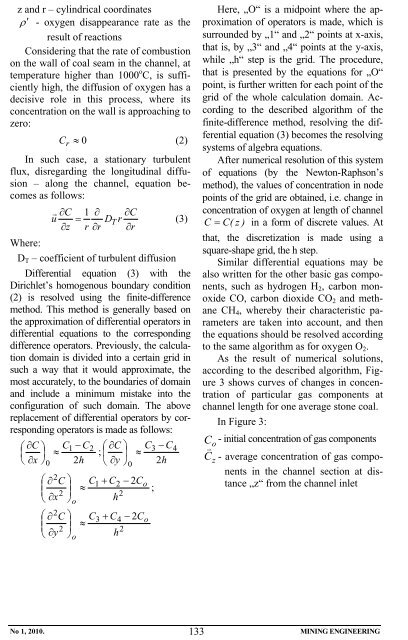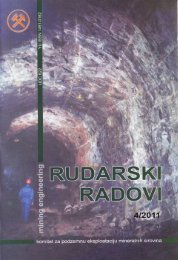Institut za rudarstvo i metalurgiju Bor
Institut za rudarstvo i metalurgiju Bor
Institut za rudarstvo i metalurgiju Bor
Create successful ePaper yourself
Turn your PDF publications into a flip-book with our unique Google optimized e-Paper software.
z and r – cylindrical coordinates<br />
ρ′ - oxygen disappearance rate as the<br />
result of reactions<br />
Considering that the rate of combustion<br />
on the wall of coal seam in the channel, at<br />
temperature higher than 1000 o C, is sufficiently<br />
high, the diffusion of oxygen has a<br />
decisive role in this process, where its<br />
concentration on the wall is approaching to<br />
zero:<br />
C r ≈ 0<br />
(2)<br />
In such case, a stationary turbulent<br />
flux, disregarding the longitudinal diffusion<br />
– along the channel, equation becomes<br />
as follows:<br />
r ∂C 1 ∂ ∂C<br />
u = DT<br />
r<br />
(3)<br />
∂z<br />
r ∂r<br />
∂r<br />
Where:<br />
DT – coefficient of turbulent diffusion<br />
Differential equation (3) with the<br />
Dirichlet’s homogenous boundary condition<br />
(2) is resolved using the finite-difference<br />
method. This method is generally based on<br />
the approximation of differential operators in<br />
differential equations to the corresponding<br />
difference operators. Previously, the calculation<br />
domain is divided into a certain grid in<br />
such a way that it would approximate, the<br />
most accurately, to the boundaries of domain<br />
and include a minimum mistake into the<br />
configuration of such domain. The above<br />
replacement of differential operators by corresponding<br />
operators is made as follows:<br />
⎛ ∂C<br />
⎞ C1<br />
− C2<br />
⎛ ∂C<br />
⎞ C3<br />
− C4<br />
⎜ ⎟ ≈ ; ⎜ ⎟ ≈<br />
⎝ ∂x<br />
⎠0<br />
2h<br />
⎝ ∂y<br />
⎠ 2h<br />
⎛ 2<br />
∂ C ⎞ C1<br />
+ C2<br />
− 2C<br />
⎜ ⎟<br />
o<br />
⎜<br />
≈<br />
2<br />
2<br />
x<br />
⎟<br />
⎝ ∂ ⎠o<br />
h<br />
⎛ 2<br />
∂ C ⎞ C3<br />
+ C4<br />
− 2C<br />
⎜ ⎟<br />
o<br />
⎜<br />
≈<br />
y2<br />
⎟<br />
h2<br />
⎝ ∂ ⎠o<br />
0<br />
;<br />
Here, „O“ is a midpoint where the approximation<br />
of operators is made, which is<br />
surrounded by „1“ and „2“ points at x-axis,<br />
that is, by „3“ and „4“ points at the y-axis,<br />
while „h“ step is the grid. The procedure,<br />
that is presented by the equations for „O“<br />
point, is further written for each point of the<br />
grid of the whole calculation domain. According<br />
to the described algorithm of the<br />
finite-difference method, resolving the differential<br />
equation (3) becomes the resolving<br />
systems of algebra equations.<br />
After numerical resolution of this system<br />
of equations (by the Newton-Raphson’s<br />
method), the values of concentration in node<br />
points of the grid are obtained, i.e. change in<br />
concentration of oxygen at length of channel<br />
C = C(<br />
z ) in a form of discrete values. At<br />
that, the discreti<strong>za</strong>tion is made using a<br />
square-shape grid, the h step.<br />
Similar differential equations may be<br />
also written for the other basic gas components,<br />
such as hydrogen H2, carbon monoxide<br />
CO, carbon dioxide CO2 and methane<br />
CH4, whereby their characteristic parameters<br />
are taken into account, and then<br />
the equations should be resolved according<br />
to the same algorithm as for oxygen O2.<br />
As the result of numerical solutions,<br />
according to the described algorithm, Figure<br />
3 shows curves of changes in concentration<br />
of particular gas components at<br />
channel length for one average stone coal.<br />
In Figure 3:<br />
C - initial concentration of gas components<br />
o<br />
Cz v - average concentration of gas components<br />
in the channel section at distance<br />
„z“ from the channel inlet<br />
No 1, 2010. 133<br />
MINING ENGINEERING



